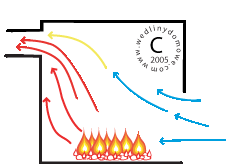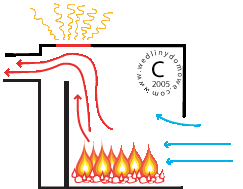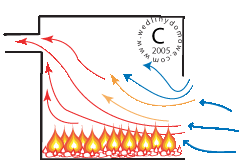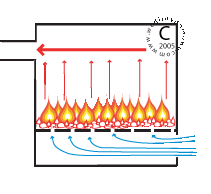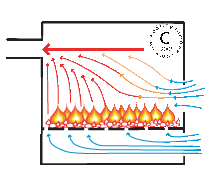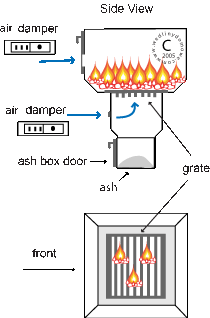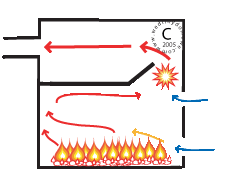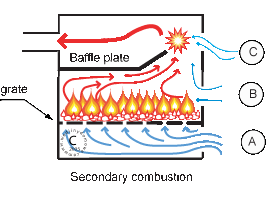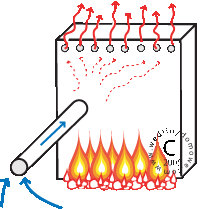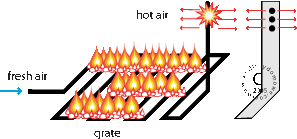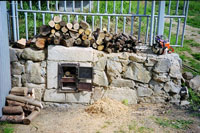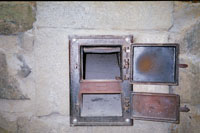Meats and Sausages
Fire Pit
A fire pit or fire box is the area of the smoker where we burn wood to produce smoke or to generate heat to cook meat products. It can be an integral part of the smoker or free standing separate unit connected to a smoker by a pipe or digged out trench in the ground. It could be a smaller barrel or a metal box. It may be made of reinforced concrete or from firebricks. The combustion efficiency inside the fire box depends on the ways fresh air is supplied into the burning wood. All smokers employ a very simple system of draft control as the the main purpose of smoking is to create smoke at low temperatures and that can be often accomplished without any draft system.
If we want to control the burning process by using fresh air dampers, how we place wood controls the rate of burning and temperatures in a fire box. A baffle can be placed vertically and it will direct heat in a different direction now. The less clearance between the top of the baffle, the more heat will be supplied to the top of the fire box.
Note warm air or smoke will always go up.
The three classical ways of placing wood in a fire box follow below:
- Directly on the ground, known as the hearth botom-grate
- Above the ground on a grate, known as a stool-grate
- Above the ground on a grate, known as a raised stool-grate
Hearth Botom Grate
The drawing below shows the most common way of positioning wood when smoking. When wood is placed directly on the ground the whole air enters frome above. This is the way fireplaces work and though all air seems to bypass the wood, enough of it reacts with fire to maintain combustion. It is obvious from the drawing that a strong draft has very little influence on a combustion process as the air will only stream faster over the fire.
The rate of combustion and temperature is controlled by the amount of wood placed in a fire pit and as the air is consumed, a new fresh air comes into its place. The rate of combustion is independent of the draft and the fire burns as if no chimney existed. To be able to control burning, the air opening has to be greatly decreased and a damper will start exercising control. Wood burns from front to back. When placing wood on the ground in a firebox with fresh air flowing in freely, the higher temperature will be in the back of a firebox or the barrel.
Stool Grate
The drawing below is an example of a closed fire box used in a heating stove. The entering air below the wood has a greater density than the hot air above the wood, this creates a difference of pressure (draft) and the only possible way is to go up through the wood. The burning coals will deprive the streaming air of its oxygen and that sets the temperature as no more fresh air is available.
Placing wood on a grate permits the introduction of primary air below the burning wood and better combustion. Here the coal bed physically separates fresh air below from the warm air above, a natural draft is created and all air has to flow through burning coals or wood. This is the most effective solution permitting a great deal of control.
Raised Stool Grate
The drawing below depicts a smaller amount of air flowing through the burning wood and the larger portion blows over the wood increasing the rate of burning. In this case the rate of combustion can be easily controlled by adjusting the air supply under the fire.
Summary on fire box types
The rate of combustion is easiest to control in the stool-grate design and most difficult in the hearth bottom-grate type. Smoking can be easily done with an open fire (hearth-bottom grate) and adding more sawdust to kindling fire allows for some control at least in respect to smoke. The raised stool grate type can be an effective tool for switching over from smoking to the cooking process. When smoking, the bottom damper has to be shut tight and the top damper open. The firebox becomes the hearth bottom-grate type and by adjusting the top damper we can choke down the air supply and the wood will start smoking. Needless to say we still need to add sawdust or wood chips into the hot coals.
To control combustion and temperatures when cooking, a bottom damper can be adjusted to provide more air which will increase the burning rate and will create more heat and higher temperatures. By the same token the amount of smoke created will be decreasing. A correctly designed stool-grate fire pit will allow to switch from smoking to cooking by opening the fresh air damper located below the grate level.
The way most smokers operate is to have an unrestricted flow of the incoming air into the flue (pipe) and the smoke is rushing from the fire pit into the smoking chamber with some unburned particles. The temperature is set by the rate of burning wood and the excess fresh air is rushing into the pipe together with the smoke. This is a welcome scenario as this fresh air brings moisture with it into the smoker preventing the drying out of sausage casings.
Note in order for the dampers to perfom their designated function, the fire box and its door must be made tight. If proper rules for efficient combustion are observed the wood becomes a very clean fuel.
The grate significantly increases the efficiency of combustion. The firebox design is further enhanced by sloping the floor of the firebox from the sidewalls down to the grate.
Sloping the floor towards the grate
Secondary combustion
Secondary combustion means adding pre-heated fresh air above the burning wood which will add fresh oxygen into the flames and the temperature will rise allowing cleaner and more efficient combustion. There will be less soot and other unburned particles and less smoke as well. This is not needed during the smoking process but may be of use when we start cooking meats.
It is achieved by placing a baffle in the rear of the fire pit to prevent smoke from rushing directly into the flue and to re-direct it into the area where a secondary air is entering the chamber. In old times the blacksmith was manually pumping more air into the fire to create high temperatures that made metals softer and pliable and that was excactly secondary combustion even though the air he supplied was not pre-heated. Incoming air is preheated in a confined but hot area before being divided into two separate streams: the primary (lower) and the secondary (higher). The smoke cannot go straight up the flue anymore and has to return to sneak through the only available opening where it picks up fresh and hot secondary air and burns cleaner now due to much higher temperatures.
Note: bluish flames indicate complete combustion
The air for secondary combustion is delivered in a higher part of the fire box, just before smoke enters the flue. The idea behind secondary combustion is to recover some of the heat that will otherwise go up the chimney by more efficient and cleaner burning of the wood. Secondary combustion can be employed in any of the fire pit arrangements as long as there is a baffle and secondary air coming close to the flue as shown in the following drawing.
The efficiency will further improve if the secondary air in C is preheated.
Preheating secondary air
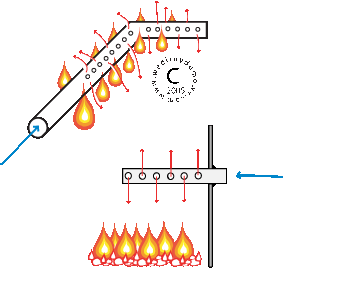
In the above drawing the pipe travels through the flame area and the air inside gets heated and escapes through a series of holes drilled in the end section of the pipe. The simplest secondary air delivery system is just a covered hole located near the upper part of the baffle. The hole can be drilled in the required area and the pipe can be directly inserted into the hole. It can be welded or threaded and secured with nuts.
Fire pit placement in smokers
If a fire pit will occupy the bottom part of a barrel some steps must be taken to slow down the flow of the smoke and evenly distribute it inside of the chamber. This requires the installation of one or two baffle plates. The heat conduction will also be slowed down and the whole smoking and cooking process will be easier to control. The unit will have higher efficiency and less wood will be consumed. A fire pit can be a 2 - 3 ft deep hole in the ground, it can be round, square, rectangular, whatever, but it has to be covered with a sheet of metal. The hole should be 18 – 24” wide, the bigger diameter the more wood can be burned inside and more heat will be produced, which may be needed when cooking at low outside temperatures. The deeper the hole the better the draft will be. Anything deeper than 3 ft will make it impractical to clean up the ashes.
A metal barrel of smaller size can be used for a fire pit or a large 55 gal (200 l) barrel can be cut in half and imbedded in the ground. A metal box of suitable dimensions can also be used. Using concrete blocks or masonry bricks will only make a temporary arrangement as they will start cracking. Firebricks and refractory fire clay is an acceptable and commonly used solution.

